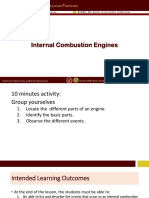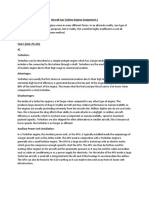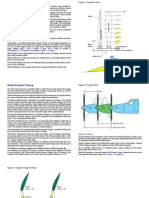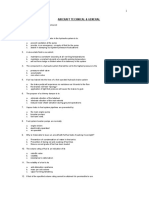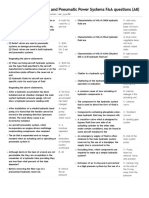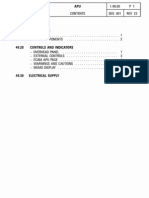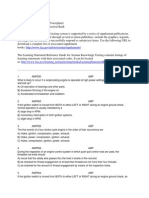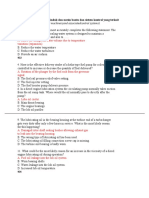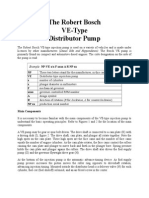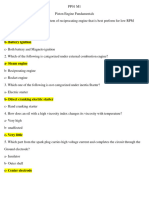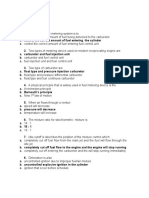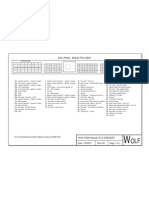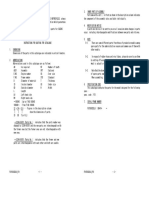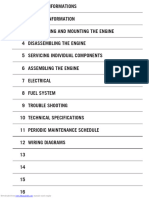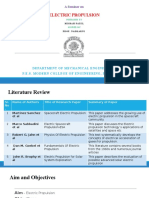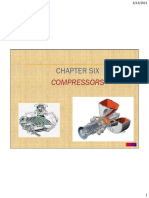Fuel Pumps Quiz
Fuel Pumps Quiz
Uploaded by
Lazaro F GomezCopyright:
Available Formats
Fuel Pumps Quiz
Fuel Pumps Quiz
Uploaded by
Lazaro F GomezOriginal Description:
Copyright
Available Formats
Share this document
Did you find this document useful?
Is this content inappropriate?
Copyright:
Available Formats
Fuel Pumps Quiz
Fuel Pumps Quiz
Uploaded by
Lazaro F GomezCopyright:
Available Formats
During what period does the fuel pump bypass valve open and remain open?
A-When the fuel pump pressure is greater than the A
demand of the engine.
B-When the boost pump pressure is greater than fuel
pump pressure.
C-When the fuel pump output is greater than the
demand of the carburetor.
Which of the following statements concerning a centrifugal-type fuel boost pump located
in a fuel supply tank is NOT true?
A-Air and fuel vapors do not pass through a
centrifugal-type pump-
B-Fuel can be drawn through the impeller section of
the pump when it is not in operation.
C-The centrifugal-type pump is classified as a positive
displacement pump.
Boost pumps in a fuel system
A-operate during takeoff only.
B-are primarily used for fuel transfer.
C-provide a positive flow of fuel to the engine pump.
(Refer to Figure 7.) What is the purpose of the fuel transfer ejectors?
A-To supply fuel under pressure to the engine driven
pump.
B-To assist in the transfer of fuel from the main tank to
the boost pump sump.
C-To transfer fuel from the boost pump sump to the
wing tank.
What is the purpose of an engine-driven fuel pump bypass valve? .
A-To divert the excess fuel back to the main tank.
B-To prevent a damaged or inoperative pump from
blocking the fuel flow of another pump in series with
it.
C-To divert the excess fuel from the pressure side of
the pump to the inlet side of the pump.
Most large aircraft reciprocating engines are equipped with which of the following types
of engine-driven fuel pumps?
A-Rotary-Vane-Type fuel pump
B-Centrifugal-type fuel pump.
C-Gear-type fuel pump.
When an electric primer is used, fuel pressure is built up by the
A-internal pump in the primer solenoid.
B-suction at the main discharge nozzle.
C-booster pump.
The fuel pump relief valve directs excess fuel to the
A-fuel tank return line.
B-inlet side of the fuel pump.
C-inlet side of the fuel strainer.
Which type of pump is commonly used as a fuel pump on reciprocating engines?
A- Gear.
B-Impeller.
C-Vane.
The purpose of the diaphragm in most vane-type fuel pumps is to
A-maintain fuel pressure below atmospheric pressure.
B-equalize fuel pressure at all speeds.
C-compensate fuel pressures to altitude changes
What is a characteristic of a centrifugal type boost pump?
A-It separates air and vapor from the fuel.
B-It has positive displacement.
C-It requires a relief valve.
The Federal Aviation Regulations require the fuel flow rate for gravity systems (main
and reserve) to be
A- 125 percent of the takeoff fuel consumption of the
engine.
B- 125 percent of the maximum, except takeoff, fuel
consumption of the engine.
C-150 percent of the takeoff fuel consumption of the
engine.
Fuel boost pumps are operated
A-to provide a positive flow of fuel to the engine.
B-during takeoff only.
C-primarily for fuel transfer to another tank.
A pilot reports that the fuel pressure fluctuates and exceeds the upper limits whenever
the throttle is advanced. The most likely cause of the trouble is
A-a ruptured fuel pump relief-valve diaphragm.
B-a sticking fuel pump relief valves
C-an air leak at the fuel pump relief-valve body.
Fuel pump relief valves designed to compensate
for atmospheric pressure variations are known as
A-compensated-flow valves.
B-pressurized-relief valves.
C-balanced-type relief valves.
If an engine equipped with a float-type carburetor
backfires or misses when the throttle is advanced, a likely
cause is that the
A-float level is too high.
B-main air bleed is clogged.
C-accelerating pump is not operating properly.
A fuel pressure relief valve is required on
A-engine-driven diaphragm-type fuel pumps
B-engine-driven vane-type fuel pumps
C-centrifugal fuel boost pumps
A rotary-vane pump is best described as a
A-positive-displacement pump
B-variable-displacement pump
C-boost pump
Fuel pressure produced by the engine-driven fuel pump is adjusted by the
A-bypass valve adjusting screw
B-relief valve adjusting screw
C-engine driven fuel pump adjusting screw
What component is used to ensure fuel delivery during periods of rapid engine
acceleration?
A-Acceleration pump,
B-Water injection pump.
C-Power enrichment unit.
What type of pump can vary the amount of fuel discharged regardless of speed
Answer - A variable displacement pump.
What is the purpose of a pressure relief valve in a constant displacement pump?
Answer - It returns is not required by the engine to the inlet side of the pump.
What type of engine-driven fuel pump is widely used other than gear or piston pumps?
Answer - A rotary vane type.
What function do fuel boost pumps perform.
Answer - They supply pressurized fuel to the fuel pump, which helps prevent vapor lock
and cavitation.
What is a commonly used type of fuel boost pump?
Answer - The centrifugal type.
What category is a gear-type pump classified in?
Answer – Constant displacement.
What maintains the fuel pressure in a pressure-injection carburetor?
Answer – An engine driven fuel pump.
When performing an external inspection of an engine-driven fuel pump what should you
look for?
Answer - Leaks and security of mounting.
What is the purpose of a shear section of the driveshaft in a dual element constant
displacement pump?
Answer - If one element seizes, a portion of the driveshaft seizes, allowing the other
element to continue to operate.
What is the purpose of a bypass valve in an engine fuel system micron filter?
Answer – It is a safety feature that allows fuel to flow to the engine if the filter becomes
blocked.
You might also like
- Engine Manual Sc25r Sc28r Saic MaxusDocument81 pagesEngine Manual Sc25r Sc28r Saic Maxusangelica lopez100% (4)
- Aircraft Engine IdentificationDocument6 pagesAircraft Engine IdentificationEarl Michaelo R. Kalacas100% (1)
- M14 (EASA) SN (PDF by MR - Raza)Document9 pagesM14 (EASA) SN (PDF by MR - Raza)Eimad Attar100% (1)
- Assesment Exam (Powerplant)Document18 pagesAssesment Exam (Powerplant)Sealtiel1020No ratings yet
- Propulsion EASA MOD 14Document1 pagePropulsion EASA MOD 14Navaraj Baniya0% (1)
- Bomba Stanadyne John DeereDocument60 pagesBomba Stanadyne John Deereyamilmr100% (20)
- Topic1 ICEDocument41 pagesTopic1 ICEsheilaNo ratings yet
- Mallory Tune Up Parts CatalogDocument5 pagesMallory Tune Up Parts CatalogbobNo ratings yet
- ATITA Questions & AnswersDocument107 pagesATITA Questions & AnswersSara Azam100% (1)
- AMP Sample ExamDocument13 pagesAMP Sample ExamJhony BhatNo ratings yet
- Airframe Continuation!...Document11 pagesAirframe Continuation!...IdrisNo ratings yet
- Atita EngineDocument36 pagesAtita EngineSara AzamNo ratings yet
- Far 43 PDFDocument30 pagesFar 43 PDFscratchstNo ratings yet
- Aircraft Fuel Systems. AYR CDocument37 pagesAircraft Fuel Systems. AYR CAKANKSHA PANDEYNo ratings yet
- Ame Licence Exam Oct2011Document20 pagesAme Licence Exam Oct2011Aviation WorldNo ratings yet
- No. Multiple Choice Questions Grammar Technical Content LevelDocument20 pagesNo. Multiple Choice Questions Grammar Technical Content LevelMonita DiazsNo ratings yet
- Q300 and B737Document35 pagesQ300 and B737Vv ZoidNo ratings yet
- Aircraft Gas Turbine Engines Assignment 2Document13 pagesAircraft Gas Turbine Engines Assignment 2Abdul MuizzNo ratings yet
- Hydraulics Dic (WWW - Ketabesabz.com)Document21 pagesHydraulics Dic (WWW - Ketabesabz.com)anon_558118723No ratings yet
- Propeller FundamentalDocument7 pagesPropeller FundamentalSharath UpadhyaNo ratings yet
- VHF Cho Phép Liên L C Gi A ?Document4 pagesVHF Cho Phép Liên L C Gi A ?Trung SơnNo ratings yet
- A300B4 Refrsher Course Exam: C-A Servo Control Sliding Valve JamDocument7 pagesA300B4 Refrsher Course Exam: C-A Servo Control Sliding Valve JamMohammad Faraz AkhterNo ratings yet
- Mod 11a PrintDocument130 pagesMod 11a Printsharma33100% (1)
- Ata 23 Communication: System OverviewDocument5 pagesAta 23 Communication: System OverviewNoorul QuamarNo ratings yet
- Aircraft Systems - Lec 3Document36 pagesAircraft Systems - Lec 3aahsan345100% (1)
- Weight and BalanceDocument11 pagesWeight and Balanceelle liNo ratings yet
- PTC B1.1 Notes - Sub Module 17.1 (Fundamentals)Document44 pagesPTC B1.1 Notes - Sub Module 17.1 (Fundamentals)DrAmir AhmedNo ratings yet
- Jet Engine MCQDocument9 pagesJet Engine MCQPrem MauryaNo ratings yet
- A321 Conversion Question Bank For Cabin CrewDocument10 pagesA321 Conversion Question Bank For Cabin CrewHoàng Việt TrungNo ratings yet
- UAE CAR 147 - Oct 17Document26 pagesUAE CAR 147 - Oct 17Vikramjeet Banerjee100% (1)
- M 17Document5 pagesM 17amhm2000100% (1)
- Engine Essay QuestionDocument7 pagesEngine Essay QuestionFikri MohamadNo ratings yet
- Classroom Activities in Aerodynamics: © 2000 Dr. Charley Rodriguez, PH.DDocument21 pagesClassroom Activities in Aerodynamics: © 2000 Dr. Charley Rodriguez, PH.DAerocse EceitmechNo ratings yet
- Guide: Training Course On Aircraft Maintenance Program A320 FamilyDocument3 pagesGuide: Training Course On Aircraft Maintenance Program A320 FamilyZ.i. HamidiNo ratings yet
- Aoa 737ngx Groundwork Engines HandoutDocument25 pagesAoa 737ngx Groundwork Engines HandoutDonald MokNo ratings yet
- Aircraft Technical & GeneralDocument10 pagesAircraft Technical & GeneralRaveena SharmaNo ratings yet
- Examen Turbina 3 ParcialDocument10 pagesExamen Turbina 3 ParcialBrayan VelascoNo ratings yet
- UG - CAO.00015 Foreign Part 147 Approvals User Guide For ApplicantsDocument39 pagesUG - CAO.00015 Foreign Part 147 Approvals User Guide For ApplicantssanjureddyNo ratings yet
- Lubrication System Maintenance2Document37 pagesLubrication System Maintenance2Zalmiers SarterezNo ratings yet
- Fuel Metering SystemDocument3 pagesFuel Metering Systemmellon3duwenNo ratings yet
- Turbine Engine Theory Oral ExamDocument7 pagesTurbine Engine Theory Oral ExamLuis AlonsoNo ratings yet
- Content: Weight and Balance Equipment Preparing An Aircraft For WeighingDocument10 pagesContent: Weight and Balance Equipment Preparing An Aircraft For WeighingMuhammad RidwanNo ratings yet
- A00006WIDocument8 pagesA00006WISantosa Edy WibowoNo ratings yet
- Car M Training Final EditedDocument180 pagesCar M Training Final EditedTDHNo ratings yet
- Hydraulic and Pneumatic Power Systems FAA Questions (A8)Document6 pagesHydraulic and Pneumatic Power Systems FAA Questions (A8)ajrio1785No ratings yet
- FAA 8083 30 - Ch12 PDFDocument46 pagesFAA 8083 30 - Ch12 PDFhocimtmNo ratings yet
- 01 Aircraft General PracticesDocument78 pages01 Aircraft General PracticesNikko basica flyboiNo ratings yet
- HF - SFAR.EWIS - UnlockedDocument19 pagesHF - SFAR.EWIS - UnlockedDavid Owen100% (1)
- CAR - 147 Approved Maintenance Training Organisation (Type Training)Document57 pagesCAR - 147 Approved Maintenance Training Organisation (Type Training)Jebin Kumar K JNo ratings yet
- Middle East Airlines Training and Development DivisionDocument11 pagesMiddle East Airlines Training and Development DivisionsebastienNo ratings yet
- A320-Auxiliary Power UnitDocument11 pagesA320-Auxiliary Power UnitNabeel S. Al WazzanNo ratings yet
- Question BankDocument20 pagesQuestion Bankadolfo3991No ratings yet
- Helicopter Transmission Test GuideDocument12 pagesHelicopter Transmission Test GuideUjata IsraelNo ratings yet
- 737-300/400/500 (CLASSIC) TYPE Training: Ata 76-Engine ControlsDocument14 pages737-300/400/500 (CLASSIC) TYPE Training: Ata 76-Engine ControlsIdrisNo ratings yet
- Type of Fuel PumpsDocument30 pagesType of Fuel PumpsPrem MauryaNo ratings yet
- Operate Main Andauxiliary Machineryand Associatedcontrol Systems-1-1-2Document21 pagesOperate Main Andauxiliary Machineryand Associatedcontrol Systems-1-1-2Rio AryaNo ratings yet
- Experiment No: Fuel Pump & Injectors AimDocument7 pagesExperiment No: Fuel Pump & Injectors Aimabbas bilalNo ratings yet
- Types of Fuel Pumps: Mechanical, Electric & High Pressure Fuel PumpDocument5 pagesTypes of Fuel Pumps: Mechanical, Electric & High Pressure Fuel PumpIman SadeghiNo ratings yet
- Working Principles of PumpsDocument60 pagesWorking Principles of PumpsPritam ShrivastavNo ratings yet
- The Robert BoschDocument15 pagesThe Robert BoschShahrizan Abdul Rahman100% (1)
- Powerplant 213Document30 pagesPowerplant 213Dave Ke AtsedNo ratings yet
- UniKL MIAT Piston 2 Mid Block TestDocument6 pagesUniKL MIAT Piston 2 Mid Block Testmellon3duwenNo ratings yet
- Operacion y Partes Compresores SullairDocument67 pagesOperacion y Partes Compresores SullairAbdul Zapata EscobarNo ratings yet
- Deutz - TCD - 914 Op 03123448 - enDocument60 pagesDeutz - TCD - 914 Op 03123448 - encankurtaranNo ratings yet
- Dyna 2000iDocument6 pagesDyna 2000iAmerico GuzmanNo ratings yet
- Parts Manual Isuzu 4JJ1 (4JJ1XASK05) EngineDocument96 pagesParts Manual Isuzu 4JJ1 (4JJ1XASK05) Enginesampathautomobile85No ratings yet
- ME410 Exp. 4 Lecture Part 1 Presentation - UpdatedDocument31 pagesME410 Exp. 4 Lecture Part 1 Presentation - UpdatedSaad KhanNo ratings yet
- Presented BY:-Pratik Gupta (Eee 5 Sem)Document21 pagesPresented BY:-Pratik Gupta (Eee 5 Sem)Necati çobanNo ratings yet
- Kubota d622 Workshop ManualDocument10 pagesKubota d622 Workshop Manualdawn98% (65)
- RD 3ld 510 Ed232886 131920Document32 pagesRD 3ld 510 Ed232886 131920bojan.gunjevicNo ratings yet
- ACDELCO Catalogue Fluids OilsDocument1 pageACDELCO Catalogue Fluids OilsKristiano TavaresNo ratings yet
- Titan Cargo 10W-40Document3 pagesTitan Cargo 10W-40Mohamed LabibNo ratings yet
- Volvo EW180C Wheeled Excavator Service Repair Manual Instant DownloadDocument21 pagesVolvo EW180C Wheeled Excavator Service Repair Manual Instant Downloadvrdmen5302No ratings yet
- Afc Rep Cap - Fixed Wing Fuel CellsDocument112 pagesAfc Rep Cap - Fixed Wing Fuel CellsEduardo Marcelo AyreNo ratings yet
- A Novel Two-Stroke SI Design For NOx Reduction in Natural Gas RI Species Enhanced EngineDocument15 pagesA Novel Two-Stroke SI Design For NOx Reduction in Natural Gas RI Species Enhanced EngineDavid BlankNo ratings yet
- Nissan S13 SR20DET To Wolf V500 Pinouts With LinkDocument1 pageNissan S13 SR20DET To Wolf V500 Pinouts With Linkwolfems88% (8)
- Caterpillar Cat 216B3 Skid Steer Loader (Prefix HR2) Service Repair Manual (HR200001 and Up)Document25 pagesCaterpillar Cat 216B3 Skid Steer Loader (Prefix HR2) Service Repair Manual (HR200001 and Up)rpoy9396615No ratings yet
- Catalogue Mitsubishi S12A2 PTADocument5 pagesCatalogue Mitsubishi S12A2 PTAmoris.wahyuNo ratings yet
- 592HP 4.6L 2V Turbo PDFDocument5 pages592HP 4.6L 2V Turbo PDFGlen YNo ratings yet
- RAIDER R150 High 833-RELOADED (FU150SCD2L6-P31)Document70 pagesRAIDER R150 High 833-RELOADED (FU150SCD2L6-P31)GAYLE GONo ratings yet
- 450 ManualDocument13 pages450 ManualJane TaylorNo ratings yet
- Experiment No 2 Ic EngineDocument4 pagesExperiment No 2 Ic EngineMuhammad TalhaNo ratings yet
- PPTDocument23 pagesPPTMisbah PatelNo ratings yet
- Engine D8-600Document2 pagesEngine D8-600jajajaparudinNo ratings yet
- UntitledDocument488 pagesUntitledivan alves100% (1)
- Chapter 6 CompressorsDocument67 pagesChapter 6 Compressorskareemaa589No ratings yet
- Despiece MOTOR KAWASAKI TJ35EDocument17 pagesDespiece MOTOR KAWASAKI TJ35EandresNo ratings yet
- Exams 2015 - Electrical MachinesDocument7 pagesExams 2015 - Electrical Machinesappiagyei nicholasNo ratings yet
- Gx340 Gx390 Assembly GuideDocument1 pageGx340 Gx390 Assembly GuideSarmad Shah100% (1)






